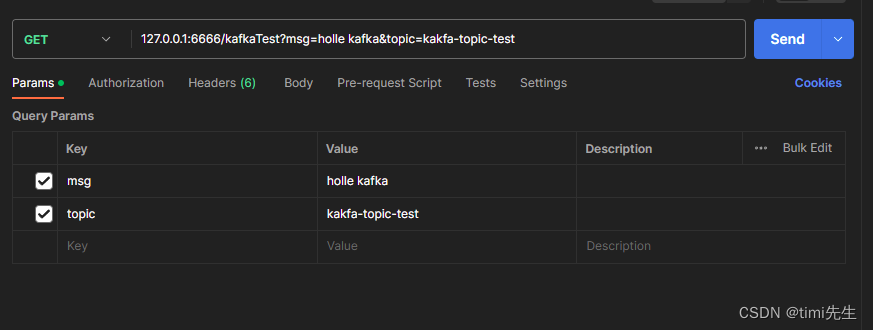青岛外贸网站推广百度官方网站首页
springboot 连接 kafka集群
- 一、环境搭建
- 1.1 springboot 环境
- 1.2 kafka 依赖
- 二、 kafka 配置类
- 2.1 发布者
- 2.1.1 配置
- 2.1.2 构建发布者类
- 2.1.3 发布消息
- 2.2 消费者
- 2.2.1 配置
- 2.2.2 构建消费者类
- 2.2.3 进行消息消费
一、环境搭建
1.1 springboot 环境
JDK 11+
Maven 3.8.x+
springboot 2.5.4 +
1.2 kafka 依赖
springboot的pom文件导入
<dependency><groupId>org.springframework.kafka</groupId><artifactId>spring-kafka</artifactId></dependency><dependency><groupId>org.springframework.kafka</groupId><artifactId>spring-kafka-test</artifactId><scope>test</scope></dependency><dependency><groupId>org.apache.kafka</groupId><artifactId>kafka-clients</artifactId><version>3.4.0</version></dependency>
二、 kafka 配置类
2.1 发布者
2.1.1 配置
发布者我们使用 KafkaTemplate 来进行消息发布,所以需要先对其进行一些必要的配置。
@Configuration
@EnableKafka
public class KafkaConfig {/***** 发布者 *****///生产者工厂@Beanpublic ProducerFactory<Integer, String> producerFactory() {return new DefaultKafkaProducerFactory<>(producerConfigs());}//生产者配置@Beanpublic Map<String, Object> producerConfigs() {Map<String, Object> props = new HashMap<>();props.put(ProducerConfig.BOOTSTRAP_SERVERS_CONFIG, "192.168.2.83:9092,192.168.2.84:9092,192.168.2.86:9092");props.put(ProducerConfig.KEY_SERIALIZER_CLASS_CONFIG, IntegerSerializer.class);props.put(ProducerConfig.VALUE_SERIALIZER_CLASS_CONFIG, StringSerializer.class);return props;}//生产者模板@Beanpublic KafkaTemplate<Integer, String> kafkaTemplate() {return new KafkaTemplate<>(producerFactory());}
}
2.1.2 构建发布者类
配置完发布者,下来就是发布消息,我们需要继承 ProducerListener<K, V> 接口,该接口完整信息如下:
public interface ProducerListener<K, V> {void onSuccess(ProducerRecord<K, V> producerRecord, RecordMetadata recordMetadata);void onError(ProducerRecord<K, V> producerRecord, RecordMetadata recordMetadata,Exception exception);}
实现该接口的方法,我们可以获取包含发送结果(成功或失败)的异步回调,也就是可以在这个接口的实现中获取发送结果。
我们简单的实现构建一个发布者类,接收主题和发布消息参数,并打印发布结果。
@Component
public class KafkaProducer implements ProducerListener<Object,Object> {private static final Logger producerlog = LoggerFactory.getLogger(KafkaProducer.class);private final KafkaTemplate<Integer, String> kafkaTemplate;public KafkaProducer(KafkaTemplate<Integer, String> kafkaTemplate) {this.kafkaTemplate = kafkaTemplate;}public void producer (String msg,String topic){ListenableFuture<SendResult<Integer, String>> future = kafkaTemplate.send(topic,0, msg);future.addCallback(new KafkaSendCallback<Integer, String>() {@Overridepublic void onSuccess(SendResult<Integer, String> result) {producerlog.info("发送成功 {}", result);}@Overridepublic void onFailure(KafkaProducerException ex) {ProducerRecord<Integer, String> failed = ex.getFailedProducerRecord();producerlog.info("发送失败 {}",failed);}});}}
2.1.3 发布消息
写一个controller类来测试我们构建的发布者类,这个类中打印接收到的消息,来确保信息接收不出问题。
@RestController
public class KafkaTestController {private static final Logger kafkaTestLog = LoggerFactory.getLogger(KafkaTestController.class);@Resourceprivate KafkaProducer kafkaProducer;@GetMapping("/kafkaTest")public void kafkaTest(String msg,String topic){kafkaProducer.producer(msg,topic);kafkaTestLog.info("接收到消息 {} {}",msg,topic);}
}一切准备就绪,我们启动程序利用postman来进行简单的测试。
进行消息发布:

发布结果:

可以看到消息发送成功。
我们再看看kafka消费者有没有接收到消息:

看以看到,kakfa的消费者也接收到了消息。
2.2 消费者
2.2.1 配置
消息的接受有多种方式,我们这里选择的是使用 @KafkaListener 注解来进行消息接收。它的使用像下面这样:
public class Listener {@KafkaListener(id = "foo", topics = "myTopic", clientIdPrefix = "myClientId")public void listen(String data) {...}}
看起来不是太难吧,但使用这个注解,我们需要配置底层 ConcurrentMessageListenerContainer.kafkaListenerContainerFactor。
我们在原来的kafka配置类 KafkaConfig 中,继续配置消费者,大概就像下面这样
@Configuration
@EnableKafka
public class KafkaConfig {/***** 发布者 *****///生产者工厂@Beanpublic ProducerFactory<Integer, String> producerFactory() {return new DefaultKafkaProducerFactory<>(producerConfigs());}//生产者配置@Beanpublic Map<String, Object> producerConfigs() {Map<String, Object> props = new HashMap<>();props.put(ProducerConfig.BOOTSTRAP_SERVERS_CONFIG, "192.168.2.83:9092,192.168.2.84:9092,192.168.2.86:9092");props.put(ProducerConfig.KEY_SERIALIZER_CLASS_CONFIG, IntegerSerializer.class);props.put(ProducerConfig.VALUE_SERIALIZER_CLASS_CONFIG, StringSerializer.class);return props;}//生产者模板@Beanpublic KafkaTemplate<Integer, String> kafkaTemplate() {return new KafkaTemplate<>(producerFactory());}/***** 消费者 *****///容器监听工厂@BeanKafkaListenerContainerFactory<ConcurrentMessageListenerContainer<Integer, String>>kafkaListenerContainerFactory() {ConcurrentKafkaListenerContainerFactory<Integer, String> factory =new ConcurrentKafkaListenerContainerFactory<>();factory.setConsumerFactory(consumerFactory());factory.setConcurrency(3);factory.getContainerProperties().setPollTimeout(3000);return factory;}//消费者工厂@Beanpublic ConsumerFactory<Integer, String> consumerFactory() {return new DefaultKafkaConsumerFactory<>(consumerConfigs());}//消费者配置@Beanpublic Map<String, Object> consumerConfigs() {Map<String, Object> props = new HashMap<>();props.put(ConsumerConfig.BOOTSTRAP_SERVERS_CONFIG,"192.168.2.83:9092,192.168.2.84:9092,192.168.2.86:9092");props.put(ConsumerConfig.VALUE_DESERIALIZER_CLASS_CONFIG, ErrorHandlingDeserializer.class);props.put(ConsumerConfig.KEY_DESERIALIZER_CLASS_CONFIG, ErrorHandlingDeserializer.class);props.put(ErrorHandlingDeserializer.KEY_DESERIALIZER_CLASS, JsonDeserializer.class);props.put(ErrorHandlingDeserializer.VALUE_DESERIALIZER_CLASS, JsonDeserializer.class.getName());props.put(ConsumerConfig.REQUEST_TIMEOUT_MS_CONFIG,3000);return props;}
}
注意,要设置容器属性必须使用getContainerProperties()工厂方法。它用作注入容器的实际属性的模板
2.2.2 构建消费者类
配置好后,我们就可以使用这个注解了。这个注解的使用有多种方式:
1、用它来覆盖容器工厂的concurrency和属性
@KafkaListener(id = "myListener", topics = "myTopic",autoStartup = "${listen.auto.start:true}", concurrency = "${listen.concurrency:3}")
public void listen(String data) {...
}2、可以使用显式主题和分区(以及可选的初始偏移量)
@KafkaListener(id = "thing2", topicPartitions ={ @TopicPartition(topic = "topic1", partitions = { "0", "1" }),@TopicPartition(topic = "topic2", partitions = "0",partitionOffsets = @PartitionOffset(partition = "1", initialOffset = "100"))})
public void listen(ConsumerRecord<?, ?> record) {...
}3、将初始偏移应用于所有已分配的分区
@KafkaListener(id = "thing3", topicPartitions ={ @TopicPartition(topic = "topic1", partitions = { "0", "1" },partitionOffsets = @PartitionOffset(partition = "*", initialOffset = "0"))})
public void listen(ConsumerRecord<?, ?> record) {...
}4、指定以逗号分隔的分区列表或分区范围
@KafkaListener(id = "pp", autoStartup = "false",topicPartitions = @TopicPartition(topic = "topic1",partitions = "0-5, 7, 10-15"))
public void process(String in) {...
}5、可以向侦听器提供Acknowledgment
@KafkaListener(id = "cat", topics = "myTopic",containerFactory = "kafkaManualAckListenerContainerFactory")
public void listen(String data, Acknowledgment ack) {...ack.acknowledge();
}6、添加标头
@KafkaListener(id = "list", topics = "myTopic", containerFactory = "batchFactory")
public void listen(List<String> list,@Header(KafkaHeaders.RECEIVED_KEY) List<Integer> keys,@Header(KafkaHeaders.RECEIVED_PARTITION) List<Integer> partitions,@Header(KafkaHeaders.RECEIVED_TOPIC) List<String> topics,@Header(KafkaHeaders.OFFSET) List<Long> offsets) {...
}我们这里写一个简单的,只用它来接受指定主题的数据:
@Component
public class KafkaConsumer {private static final Logger consumerlog = LoggerFactory.getLogger(KafkaConsumer.class);@KafkaListener(topicPartitions = @TopicPartition(topic = "kafka-topic-test",partitions = "0"))public void consumer (String data){consumerlog.info("消费者接收数据 {}",data);}
}
这里解释一下,因为我们进行了手动分配主题/分区,所以 注解中group.id 可以为空。若要指定group.id请在消费者配置中加上props.put(ConsumerConfig.GROUP_ID_CONFIG, “bzt001”); 或在 @TopicPartition 注解后加上 groupId = “组id”
2.2.3 进行消息消费
继续使用postman调用我们写好的发布者发布消息,观察控制台的消费者类是否有相关日志出现。

